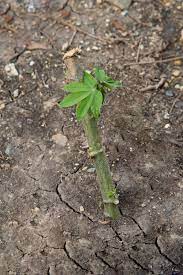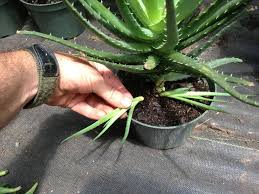Cassava Stems: Economic Importance, Uses and By-Products
Cassava stems refer to the above-ground parts of the cassava plant (Manihot esculenta), a tropical and subtropical root crop that is a significant source of carbohydrates in many parts of the world. Cassava stems are typically slender, woody, and cylindrical in shape. They can vary in length, with mature stems often reaching heights of 1 to 3 meters (3 to 10 feet).
The stems are covered with a rough and sometimes slightly peeling bark, which can be brown or grayish in color. They have a firm and sturdy texture due to their woody nature. Cassava stems consist of nodes and internodes. Nodes are the points on the stem where leaves and branches emerge, while internodes are the segments of stem between nodes.
Cassava stems bear leaves at the nodes, which are palmate and composed of multiple leaflets. The leaves are typically green and contribute to the plant’s ability to photosynthesize and produce energy. Cassava stems can produce lateral branches at the nodes, which can give rise to new cassava plants if they come into contact with soil and establish roots. These branches are important for propagation.
One of the notable features of cassava stems is their ability to store starch and other nutrients, which serves as a reserve for the plant. This storage capacity allows cassava to withstand periods of drought and recover from damage. Cassava stems can be susceptible to pests and diseases, such as mealybugs and cassava mosaic disease, which can impact plant health and reduce crop yields.
Cassava stems are commonly harvested for propagation purposes. Farmers select healthy stems from mature cassava plants to cut into segments, which are then planted to grow new cassava crops.nWhile cassava stems are primarily used for propagation, they are not typically consumed as a food source. The edible part of the cassava plant is the starchy root, which is a staple in many diets worldwide.
Cassava stems are the above-ground parts of the cassava plant, consisting of nodes and internodes, leaves, and the potential for branching. They play a crucial role in cassava propagation and serve as a reserve for the plant’s energy needs, making cassava a hardy and resilient crop in various environmental conditions.
The Economic Importance and Uses of Cassava Stems

Cassava is a versatile crop that serves as a significant source of livelihood and income for millions of people in tropical and subtropical regions. While most of the economic value is associated with the cassava tuberous roots, various parts of the cassava plant, including the stems, also have economic importance and uses:
1. Propagation of Cassava Plants: Cassava stems are primarily used for propagating new cassava plants. Farmers cut the stems into sections, each containing several nodes, and plant them in the ground. This allows for the rapid expansion of cassava cultivation. The stems are a cost-effective means of expanding cassava production compared to planting seeds.
2. Income Generation: Farmers can sell cassava stem cuttings to other farmers, creating an additional source of income. The demand for high-quality cassava stems is often high in regions where cassava is a staple crop.
3. Disease Control: The use of healthy stems for propagation helps control the spread of diseases and pests in cassava crops. By using disease-free stems, farmers can reduce the risk of crop losses due to pests and pathogens.
4. Crop Rotation: Cassava stems can also be used in crop rotation systems. By planting cassava in rotation with other crops, farmers can improve soil health and reduce the risk of soil degradation.
5. Animal Feed: Cassava stems, though not as nutritious as the tuberous roots, can still serve as a source of animal feed. They are often fed to livestock, such as cattle and goats, helping to supplement their diet.
6. Energy Production: In some regions, cassava stems are used as a source of bioenergy. They can be processed into biofuels like ethanol or used as a feedstock for biogas production. This contributes to renewable energy generation and reduces dependence on fossil fuels.
Read Also: Currant Leaf scars: Economic Importance, Uses and By-Products
7. Handicrafts and Construction: In some cultures, cassava stems are used for making handicrafts and construction materials. They can be woven into baskets, mats, and fences, or used as stakes for building temporary structures.
8. Medicinal Uses: Traditional medicine practitioners in some areas use cassava stems for their medicinal properties. They may be employed in remedies for various ailments, although their efficacy and safety should be researched further.
9. Erosion Control: Cassava stems can be used for erosion control, particularly on slopes prone to soil erosion. Planting cassava along contours or on slopes can help stabilize the soil.
10. Biomass and Composting: Cassava stems, along with other agricultural residues, can be used as biomass for energy production or added to compost piles to improve soil fertility.
The Products and By-products That Can Be Derived From Cassava Stems
Cassava (Manihot esculenta) is a versatile tropical root crop that is cultivated for its starchy tuberous roots, but various parts of the cassava plant, including the stems, can yield different products and by-products.
Here’s a list and explanation of some of the products and by-products that can be derived from cassava stems:
1. Cassava Stem Cuttings: Cassava stems can be used to propagate new cassava plants. Farmers often cut healthy stems into sections containing several nodes (the parts where leaves and roots grow), and these stem cuttings are then planted in the soil to grow new cassava plants.
2. Livestock Feed: Cassava stems are a valuable source of livestock feed, particularly for ruminants like cattle and goats. They are rich in carbohydrates and fiber, providing energy and roughage to the animals. The stems can be dried and ground into a coarse powder to make feed supplements.
3. Mulch and Organic Matter: Cassava stems can be used as mulch in agriculture. When placed on the soil surface, they can help retain moisture, suppress weed growth, and improve soil fertility as they break down and decompose.
4. Stem Peels for Animal Feed: After the cassava tubers are harvested, the stems are often peeled. The peels can be fed to livestock as a source of supplementary feed, although they may require processing or drying to enhance their nutritional value and digestibility.
5. Biofuel Production: Cassava stems can be used in the production of biofuels, such as bioethanol and biogas. The starch content in cassava stems can be converted into ethanol through fermentation processes. Additionally, cassava stems can be used as feedstock for biogas production in anaerobic digestion systems.
6. Handicrafts: In some regions, cassava stems are used to create handicrafts and household items. They can be shaped and woven into baskets, mats, or other decorative items.
7. Traditional Medicine: In traditional medicine systems, cassava stems are sometimes used for their potential medicinal properties. They may be used in remedies for various ailments, although it’s essential to exercise caution as cassava contains toxic compounds that need to be properly processed to be safe for consumption.
8. Soil Erosion Control: Cassava stems can be used in soil erosion control measures. When planted along contours or on slopes, the stems help stabilize the soil and reduce erosion.
9. Biodegradable Materials: Cassava stems can be used in the production of biodegradable materials and packaging. The cellulose fibers in the stems can be extracted and used as a raw material in biodegradable plastics and paper products.
10. Compost: Cassava stems, along with other organic matter, can be composted to create nutrient-rich organic fertilizer for agriculture.
In conclusion, it is important to note that while cassava stems offer various benefits and opportunities for utilization, they also contain cyanogenic glycosides, which can release toxic cyanide when consumed. Proper processing techniques, such as peeling and boiling, are necessary to make cassava products safe for human consumption. Additionally, care should be taken to manage the environmental impact of cassava cultivation and processing practices.
Read Also: Copper Wastes (Scrap Copper) Complete Money Making Guide









